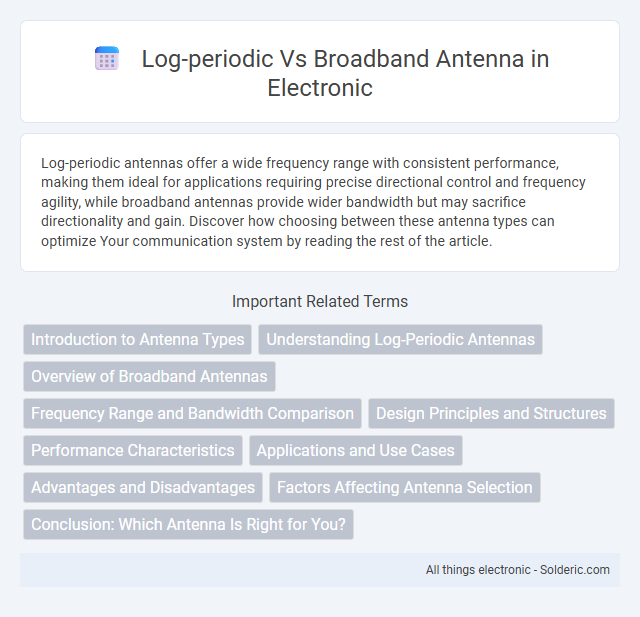Log-periodic antennas offer a wide frequency range with consistent performance, making them ideal for applications requiring precise directional control and frequency agility, while broadband antennas provide wider bandwidth but may sacrifice directionality and gain. Discover how choosing between these antenna types can optimize Your communication system by reading the rest of the article.
Comparison Table
| Feature | Log-Periodic Antenna | Broadband Antenna |
|---|---|---|
| Frequency Range | Wide, typically 2:1 to 10:1 ratio | Extremely wide, sometimes beyond 20:1 ratio |
| Design | Array of dipoles with gradually varying lengths and spacing | Various designs including discone, spiral, or biconical |
| Gain | Moderate to high (5-10 dBi) | Lower to moderate (2-8 dBi) |
| Polarization | Usually linear | Linear or circular, depending on type |
| Size | Medium to large depending on frequency | Varies widely; compact designs available |
| Applications | TV reception, HF/VHF/UHF communications, EMC testing | EMC testing, spectrum monitoring, multi-band communications |
| Impedance | Typically ~50 ohms | Varies, often matched to 50 or 75 ohms |
| Radiation Pattern | Directional with moderate beamwidth | Omnidirectional to directional, depending on design |
| Cost | Moderate | Varies; some designs can be more expensive |
Introduction to Antenna Types
Log-periodic antennas offer a frequency-independent design with multiple elements arranged in a self-similar pattern, providing consistent performance across a wide range of frequencies. Broadband antennas deliver wide bandwidth capabilities with a single continuous structure, enabling efficient signal transmission and reception over diverse frequency bands. Your choice between log-periodic and broadband antennas depends on the need for frequency stability versus bandwidth efficiency in specific communication applications.
Understanding Log-Periodic Antennas
Log-periodic antennas feature a self-similar structure with elements of varying lengths and spacing, enabling wideband frequency coverage and stable radiation patterns across multiple octaves. Their design relies on frequency-independent operation, achieved through a tapered array of dipole elements, making them highly versatile for applications requiring consistent performance over a broad spectrum. Compared to broadband antennas, log-periodic antennas offer enhanced directivity and gain, while maintaining impedance matching across a wide frequency range, which is critical for precise signal reception and transmission.
Overview of Broadband Antennas
Broadband antennas are designed to operate efficiently over a wide range of frequencies, providing consistent performance in diverse communication applications. These antennas utilize various design techniques such as spiral, Vivaldi, and log-periodic structures to achieve broad impedance bandwidth and stable radiation patterns. Their ability to maintain high gain and low VSWR across multiple frequency bands makes them ideal for radar, wireless systems, and spectrum monitoring.
Frequency Range and Bandwidth Comparison
Log-periodic antennas offer a wide frequency range with a consistent radiation pattern and gain across multiple octaves, making them ideal for applications requiring stable performance over a broad spectrum. Broadband antennas provide even broader bandwidth but often sacrifice gain uniformity and radiation efficiency at the extremes of their frequency range. Your choice depends on whether a uniform antenna gain (log-periodic) or maximum bandwidth (broadband) is more critical for your specific communication needs.
Design Principles and Structures
Log-periodic antennas feature a self-similar structure with elements of varying lengths and spacing arranged in a repetitive, scaled pattern, enabling wideband frequency coverage by maintaining consistent electrical properties across frequencies. Broadband antennas utilize continuous or smoothly varying geometries, such as tapered slots or resistive loading, to achieve wide frequency response with minimal variations in impedance and radiation pattern. The design principle of log-periodic antennas relies on scaling and element resonance, whereas broadband antennas emphasize impedance matching and gradual transition of energy to support wide spectral operation.
Performance Characteristics
Log-periodic antennas offer high directivity and stable gain across a wide frequency range, ideal for applications requiring consistent performance over multiple bands. Broadband antennas provide a wider frequency coverage with relatively uniform radiation patterns but often at the cost of lower gain and increased size. Your choice depends on whether sustained gain or maximum bandwidth is more critical for your communication needs.
Applications and Use Cases
Log-periodic antennas excel in applications requiring wideband frequency coverage with directional characteristics, such as television broadcasting, radar systems, and wireless communication testing. Broadband antennas are preferred in scenarios demanding ultra-wide impedance bandwidth and stable radiation patterns, including UWB communications, spectrum monitoring, and electromagnetic compatibility testing. Both antenna types accommodate diverse industry needs, with log-periodic antennas favored for high-gain directional uses and broadband antennas chosen for their consistent performance over extensive frequency ranges.
Advantages and Disadvantages
Log-periodic antennas offer wide frequency coverage with moderate gain, making them ideal for applications requiring consistent performance across a broad spectrum; however, their design complexity and size can be drawbacks. Broadband antennas provide ultra-wide frequency ranges with simpler designs and smaller form factors, but they often suffer from lower gain and less directional control compared to log-periodic types. Choosing between the two depends on specific needs for frequency range, gain, size, and application environment.
Factors Affecting Antenna Selection
Factors affecting antenna selection include frequency range, gain, and radiation pattern requirements. Log-periodic antennas provide wide bandwidth and moderate gain, making them suitable for variable frequency applications, while broadband antennas offer consistent performance over a wide frequency range with lower gain. Your choice depends on the specific signal coverage, size constraints, and directional needs of the communication system.
Conclusion: Which Antenna Is Right for You?
Log-periodic antennas offer wide frequency coverage with moderate gain and directional properties, making them ideal for applications requiring frequency agility and moderate directivity, such as TV reception and frequency scanning. Broadband antennas provide consistent performance over a broad frequency range with relatively uniform impedance, better suited for applications needing stable signal quality and omni-directional coverage like Wi-Fi routers and cellular base stations. Choosing between them depends on specific needs for frequency range, gain, directivity, and application environment.
log-periodic vs broadband antenna Infographic

 solderic.com
solderic.com